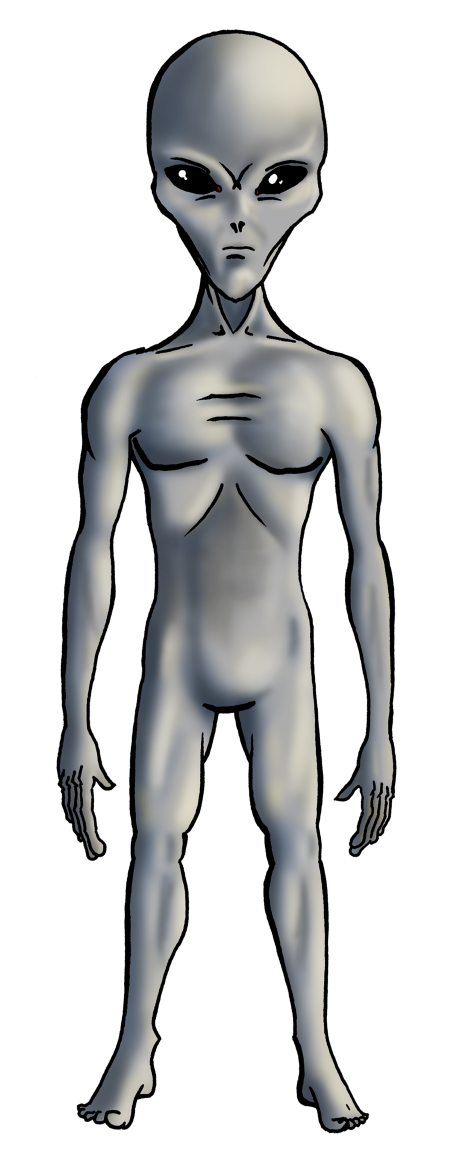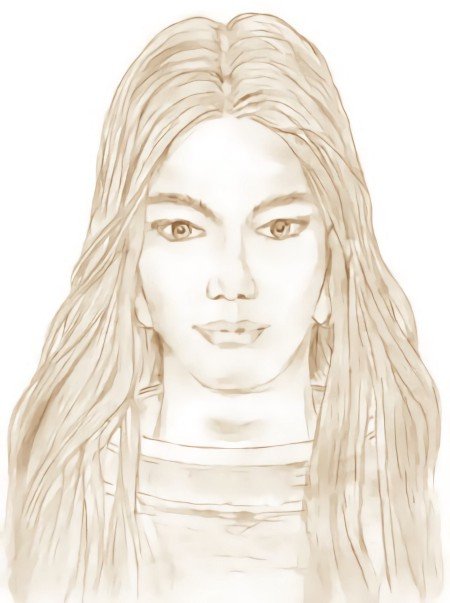
Mjolnirpants via Wikipedia Commons
I’ve always found the popular depiction of Grey aliens to be suspiciously human-like. Their anatomy is extremely close to humans and unmistakably of simian descent. Greys match up pretty closely with what the public would draw you if you asked them to guess at what evolution would turn future humans into.

Mjolnirpants via Wikipedia Commons
Some have speculated greys are future humans, but they have certain cartoonishly improbable anatomical qualities which inspire doubt. Like the weight of their heads versus neck thickness, and general apparent muscle mass, or the size and shape of their eye openings suggesting eyeballs too large to fit into their heads.
In order for these qualities to make sense from a biomechanics standpoint, you’d need their eyeballs to occupy most of the interior volume of their skulls, and for their brains to be very small. That is inconsistent with the view that greys possess highly developed intelligence.

HannahMoss via Wikipedia Commons
Likewise with reptilians. Why would independently evolved life so closely resemble any recognizable branch of Earthly taxonomy? Reptilians just look like the popular imagination of what dinosaurs might’ve evolved into, if convergent evolution to humanoids was for some reason inevitable.
Nordics likewise seem like a self gratifying cosmic idealization, even deification of Nordic, or “Aryan” beauty standards. I would speculate Nordic aliens are a conscious or subconscious expression of old fashioned racial anxiety concerning the long term preservation and expression of Scandinavian features in human populations.
It feels more plausible to me than an independently evolved species of aliens that just happen to look like a Nazi wet dream. Had we been visited by actual authentic aliens which had close encounters with humans who lived to speak and write about it, I feel like they would’ve been a great deal stranger than these. Even human sci-fi authors in the modern day know enough to be more imaginative than lizard people, little grey/green men, or space Aryans.

Wander Mahet Public Domain
One defense I’ve heard of why all these aliens are humanoids is convergent evolution. We should expect to find a lot of alien crabs in the oceans of exoplanets due to carcinisation, or at least recognizably crab-like things. However, many of the traits we associate with certain taxa didn’t need to be like that. Exotic evolutionary flukes like the platypus, a duck billed egg laying mammal with venom glands, illustrates this.
I feel it reasonable to expect a body plan that isn’t too wild since evolution is miserly and usually takes place under near-starvation conditions. You don’t need a hundred legs to locomote efficiently for example, and there are no compelling use cases for six complex eyes that would justify the calories used up in growing them.
However I would also expect it to have a mixture of features we associate with irreconcilable Earthly taxa. Features we normally wouldn’t think “go together” on account of genetic distance, just because of how conditions led alien evolution down a different path than Earthly fauna.
I’m not yet sold on UAPs being of alien origin, or that if they are, that they’re not just autonomous probes or something. Recent revelations by the government do push me further in that direction, but if indeed there are intelligent ETs either piloting UAPs or instructing them remotely, I feel justified in doubting that they resemble Swedish babes or saurian hominids.
Not that either one wouldn’t be absolutely radical though, don’t get me wrong. Who doesn’t want first contact with hot blondes or dinosapiens? I’m just reminded of the maxim, “truth is not only stranger than we suppose. It’s stranger than we can suppose”.
I am almost positive the modern round of UAPs are a military game in order to justify increased defense spending.
Maybe we can use it as a pretext for building military Moon bases...
Some part of belief or conception of bipedal aliens can be explained by extrapolating from ourselves but the other significant part has to be sci-fi television and movies, and the practicality of representing alien characters with anything but actors wearing alien costumes and makeup. But I think there may be a natural funnel towards bipedalism too.
While acknowledging my own limitations of experience and bias towards what I know, I think there are universal factors that would point to bipedalism in a species of growing intelligence that eventually extends its reach beyond their gravity well: Macro life that becomes intelligent has to start with some locomotion and jumping ahead a few steps, we end up with limbs. If these limbs become versatile enough, and there is enough executive function in an alien creature, they can be used to do more than mobility and defensive/offensive tasks. They will be used for more efficient energy consumption, and eventually tool use. And using tools, energy efficiency would trend towards limbs dedicated for tasks. Three points of contact is needed for stability of a static object, but two is enough with the benefit of balance. Taking into account the efficiency of horizontal symmetry, it's likely we'd see an alien creature intelligent enough to leave its own planet with two legs, and two or more arms with digits on the end of them. The "head" is likely to sit on top, because having optical, auditory, and energy (including "taste/smell") inputs up higher has big evolutionary advantages, and the executive organ(s) will be nearby for minimum latency.
What do you think? Am I too biased by what I know of life here? I'm open to other forms of intelligent life, stranger than I can imagine (Color Out of Space is a great movie by the way, check it out :) but I should still acknowledge that I'm looking through my own limited lens. For a planet-bootstrapped form of intelligent life though, I think natural forces would make them look a bit like us.
A thing thing that roughly mimics a human, but is not a human.
A spider that roughly mimics an ant, but is not an ant.
#3spoop5me